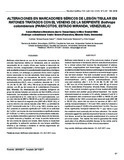Mostrar el registro sencillo del ítem
Alteraciones en marcadores séricos de lesión tisular en ratones tratados con el veneno de la serpiente bothrops colombiensis (Paracotos, Estado Miranda, Venezuela)
| dc.rights.license | http://creativecommons.org/licenses/by-nc-sa/3.0/ve/ | es_VE |
| dc.contributor.author | Duque Zerpa, Carmen Teresa | |
| dc.contributor.author | Scannone, Héctor | |
| dc.contributor.author | Vargas, Alba M. | |
| dc.date.accessioned | 2018-05-02T15:57:06Z | |
| dc.date.available | 2018-05-02T15:57:06Z | |
| dc.date.issued | 2018-03 | |
| dc.identifier.issn | 0798-2259 | |
| dc.identifier.uri | http://www.saber.ula.ve/handle/123456789/44710 | |
| dc.description.abstract | Bothrops colombiensis es una de las serpientes venenosas de elevada importancia médica en Venezuela, esta se considera responsable de un cuadro clínico que implica el desarrollo de edema, necrosis, coagulopatias y hemorragias. La gravedad de este accidente promovió la caracterización bioquímica y biológica de su veneno, sin embargo su potencial tóxico sobre órganos blanco esenciales no ha sido estudiado. Este trabajo evaluó las alteraciones séricas en marcadores de lesión, como creatina fosfoquinasa (CK), aspartato aminotransferasa (AST), alanina aminotransferasa (ALT), urea y creatinina, después de 1; 3; 6; 15; 24; 48; 72; 96; 120; 144 y 168 horas (h) del tratamiento de ratones, con 40 μg del veneno de B. colombiensis (Paracotos. Edo. Miranda), vía intramuscular. Los controles incluyeron un grupo de ratones tratados con solución de NaCl 0,85% y otro sin tratamiento. Los resultados obtenidos evidenciaron el incremento en la actividad de la CK, entre las 3 y 15 h post-tratamiento, con un valor máximo de 4001 ± 196,58 U/L a las 6 h, adicionalmente a las 144 h se observó un segundo pico (2831,40 ± 102,67 U/L), el cual no retornó a los valores basales a las 168 h. La actividad de la AST incrementó entre las 1-15 h y a las 144 h, mientras que la ALT presentó un aumento significativo (P< 0,05) en su actividad de 1 a 24 h. Los niveles de urea incrementaron significativamente (P< 0,05) de 1 a 144 h y la creatinina fue prácticamente inalterada. Los resultados obtenidos sugieren el rápido desarrollo de lesiones en tejido muscular y hepático, así como la posible instauración de una uremia de causas pre-renales. Esto implica la necesidad de garantizar la aplicación oportuna de una terapia antiofídica efectiva a las víctimas y mantener el estricto seguimiento del cuadro clínico que se presente. | es_VE |
| dc.language.iso | es | es_VE |
| dc.publisher | SABER-ULA | es_VE |
| dc.rights | info:eu-repo/semantics/openAccess | es_VE |
| dc.subject | Bothrops colombiensis | es_VE |
| dc.subject | CK | es_VE |
| dc.subject | ALT | es_VE |
| dc.subject | AST | es_VE |
| dc.subject | urea | es_VE |
| dc.title | Alteraciones en marcadores séricos de lesión tisular en ratones tratados con el veneno de la serpiente bothrops colombiensis (Paracotos, Estado Miranda, Venezuela) | es_VE |
| dc.title.alternative | Serum Markers Alterations due to Tissue Injury in Mice Treated With Bothrops colombiensis Snake Venom (Paracotos, Miranda State, Venezuela) | es_VE |
| dc.type | info:eu-repo/semantics/article | es_VE |
| dc.description.abstract1 | Bothrops colombiensis is one of the poisonous snakes of great medical importance in Venezuela, which is considered responsible for a clinical picture that involves the development of edema, necrosis, coagulopathies and hemorrhages. The severity of this accident promoted the biochemical and biological characterization of its venom; however its toxic potential on essential target organs has not been studied. This work evaluated serum alterations in injury markers, such as creatine phosphokinase (CK), aspartate aminotransferase (AST), alanine aminotransferase (ALT), urea and creatinine, after 1, 3, 6, 15, 24, 48, 72, 96, 120, 144 y 168 hour (h) of the treatment of mice, with 40 μg of venom from B. colombiensis (Paracotos, Miranda State), intramuscular route. The controls included a group of mice treated with 0.85% NaCl solution and another group without treatment. The results obtained showed an increase in CK activity, between 3 and 15 h after treatment, with a maximum value of 4001 ± 196.58 U/L at 6 h, in addition to the 144 h a second was observed peak (2831.40 ± 102.67 U/L), which did not return to baseline at 168 h. AST activity increased between 1-15 h and 144 h, while ALT showed a significant increase (P <0.05) in its activity from 1 to 24 h. The urea levels significantly increased between the 1st and 144 th h and the creatinine level practically did not have alteration. The results obtained suggest the rapid development of lesions in muscle and liver tissue, as well as the possible establishment of a uremia of pre-renal causes. This implies the need to guarantee the timely application of an effective antiofidic therapy to the victims and to maintain the strict follow-up of the clinical presentation. | es_VE |
| dc.description.colacion | 97-103 | es_VE |
| dc.identifier.depositolegal | pp199102ZU46 | |
| dc.identifier.edepositolegal | ppi201502ZU4665 | |
| dc.identifier.eissn | 2477-944X | |
| dc.publisher.pais | Venezuela | es_VE |
| dc.subject.institucion | Universidad del Zulia (LUZ) | es_VE |
| dc.subject.institucion | Universidad de Los Andes (ULA) | es_VE |
| dc.subject.keywords | Bothrops colombiensis | es_VE |
| dc.subject.keywords | CK | es_VE |
| dc.subject.keywords | ALT | es_VE |
| dc.subject.keywords | AST | es_VE |
| dc.subject.keywords | urea | es_VE |
| dc.subject.publicacionelectronica | Revista Científica | |
| dc.subject.thematiccategory | Medio Ambiente | es_VE |
| dc.subject.tipo | Revistas | es_VE |
| dc.type.media | Texto | es_VE |
Ficheros en el ítem
Este ítem aparece en la(s) siguiente(s) colección(ones)
-
Revista Científica - 2018 - Vol.XXVIII - No. 002
Marzo - Abril 2018


